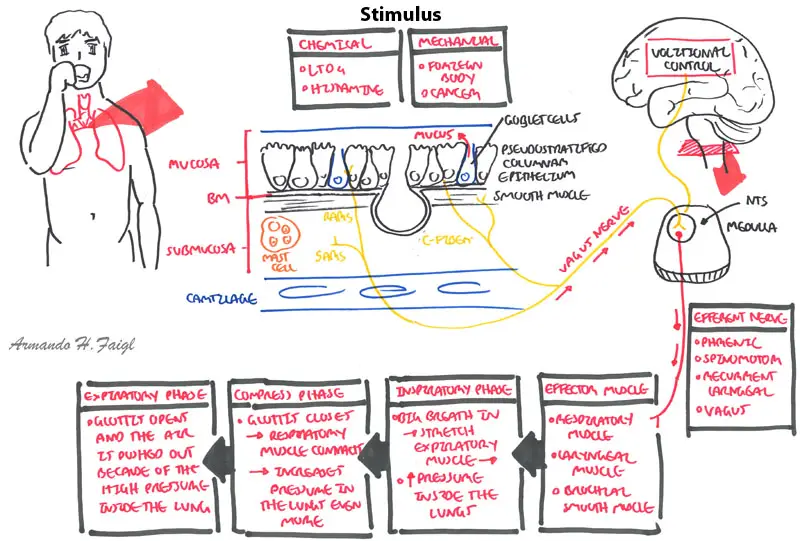Cough


Cough is initiated as a series of respiratory maneuvers that leads to a sudden expulsion of air creating a characteristic cough sound. Cough is a symptom that has been experienced by every human and is an essential innate protective mechanism that ensures the removal of mucus, noxious substances, and infections from the larynx, trachea, and large bronchi. Cough also minimizes the inhalation of toxic material. Because cough is a normal defensive mechanism, it is a symptom experienced by healthy individuals.
Acute and Chronic Cough An acute cough due to an upper respiratory virus infection generally lasts for no more than 3 weeks, although some postviral coughs may persist for many weeks or months. Thus, a chronic cough is considered to be one that persists longer than 3 weeks.
| Defintion Acute cough: present up to 14 days/2 weeks Prolonged acute cough: lasting 2 – 3 weeks Chronic cough: present > 3 weeks |
| Think Many cigarette smokers have a chronic cough but rarely seek medical advice regarding their cough because they expect that the irritant effect of cigarette smoke is the cause of their cough. However, a change in character “out of the ordinary” or with haemoptysis may force a smoker to seek medical attention. |
| MOST COMMON CAUSES OF COUGH | |
| Acute Cough | Chronic Cough |
| Common Cold (~48 resolves) | Postnasal drip |
| Viral URTI | Asthma |
| Bacterial URTI | GORD/GERD |
| COMMON CAUSES OF COUGH | CLINICAL FEATURES |
| Acute infection | |
| Can be viral or bacterial. Usually accompanied by dyspnea and fever | |
| Whooping character of cough, associated with vomiting. Caused by bordetella pertussis |
| Inflammation of the mucous membrane in the bronchial tubes. It typically causes bronchospasm and coughing. |
| Chronic infection | |
| Overproduction of airway secretions together with a reduced clearance, often within a vicious circle of recurrent bacterial infections. Usually, the patient produces 30 mL or more of mucoid or mucopurulent sputum per day, sometimes accompanied by fever, hemoptysis, and weight loss. | |
| The major cause of chronic debilitating pulmonary disease and pancreatic exocrine deficiency in the first three decades of life. It is characterized by the triad of chronic obstructive pulmonary disease, pancreatic exocrine deficiency, and abnormally high sweat electrolyte concentrations. Characteristic pancreatic changes give the disease its name. | |
| TB is a disease caused by bacteria called Mycobacterium tuberculosis. TB spreads through the air but it is not easy to catch. In 70% of cases TB affects the lungs. But it can also affect other parts of the body, such as the lymph glands, brain, kidneys, or spine. |
| Airway disease | |
Asthma may present predominantly with cough, often nocturnal, and the diagnosis is supported by the presence of reversible airflow limitation and bronchial hyper-responsiveness. | |
| A serious, progressive and disabling condition that limits airflow in the lungs. It includes emphysema and chronic bronchitis. Strongly associated with smoking | |
| Cough: Tickly, often with nasal blockage. |
| Lung parencymal disease | |
| Unable to fully fill the lungs with air. Their lungs are restricted from fully expanding. | |
| A serious, progressive and disabling condition that limits airflow in the lungs. It includes emphysema and chronic bronchitis. Strongly associated with smoking |
| Tumours | |
| Foreign body Aspiration | |
| Cardiovascular Disease | |
| The aortic artery has enlarged to greater than 1.5 times the expected diameter. | |
| Cough: Clear sputum, worse when lying flat |
| GERD | GERD, the movement of acid and other components of gastric contents from the esophagus into the larynx and trachea, is one of the most commonly associated causes of chronic cough in all age groups. GERD may lead to symptoms such as heartburn, chest pain, a sour taste, regurgitation, and a chronic persistent cough. |
| Drugs (ACE inhibitors) | ACE inhibitors are often prescribed for the treatment of hypertension and heart failure -> causes a classic dry cough |
Cough with sputum production usually points toward conditions such as chronic bronchitis and bronchiectasis or other causes of bronchorrhea.
| Remember Smokers have a chronic cough in the mornings – usually associated with grey sputum production |
| Classical characteristics of sputum | |
| White/Grey | Smoking |
| Green/yellow | Bronchitis, bronchiectasis |
| Green and offensive | Bronchiectasis, abscess |
| Frothy, pink | Congestive heart failure |
| Very sticky and often yellow | Asthma |
| Redish (blood) | Tumour, bronchitis |
| Remember Haemoptysis most common cause is bronchitis, 90% of massive haemoptysis is from bronchial arteries (massive = >500ml/24hours) |

| Watch physiology of coughing |

Please confirm you want to block this member.
You will no longer be able to:
Please allow a few minutes for this process to complete.
Discussion